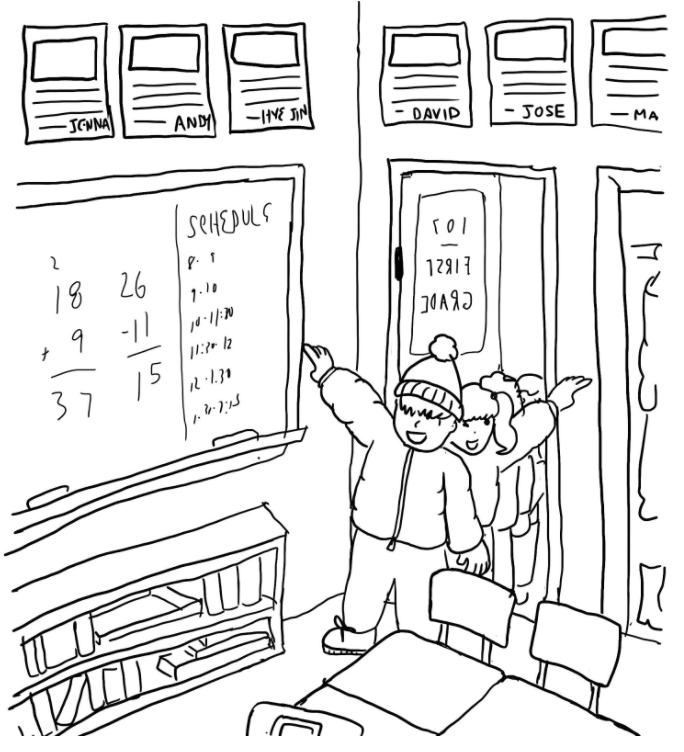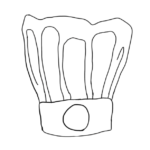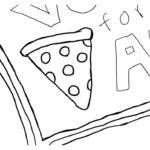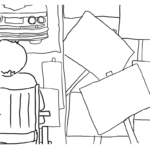
In first grade with Mrs. H, we got to write our own fiction stories, beginning to middle to end. We worked hard on them. I remember scribbling at least two versions of my story on flimsy, gray-ish drafting sheets. Only then could I transfer it to thick, white publishing paper – the kind with solid blue and dotted pink lines.
My piece was hilarious. It was a semi-autobiographical retelling of the time I tried to steal Cornflakes at the grocery store. You see, as Mom and I were walking up and down the aisles, I got very hungry. So as Mom searched the shelves for her trusty Cheerios, I slyly opened a box of Cornflakes that was in reach. In real life, Mom caught me, just as I was undoing the white cardboard tab on top of the box. In my story, I embellished a bit: I opened the box and grabbed a handful of Cornflakes. But as I tried to pull my arm back out, it got stuck! I lived my whole life as Cornflake boy, a karmic punishment for my greed and dishonesty.
Mrs. H loved my story. “So funny! Such imagination!” she exclaimed as she read the first draft. I remember the buoyant pride I felt, even now.
After everyone had written their final drafts, we got to illustrate them. We spent that morning trading bright cray pas as we drew our most important scenes. That afternoon, as we filed in from recess, we saw that Mrs. H had hung our stories high up high, all around the classroom. They nearly touched the ceiling! We bubbled with excitement and craned our necks to see our stories better. Our big, boxy print letters and colorful illustrations brightened the room.
For the rest of the afternoon, I tried to pay attention to Mrs. H’s lessons. But mostly, I stared at the stories. I scanned, left to right, blackboard to closet, wondering at the titles and the illustrations. On the bottom right corner of each story, Mrs. H had re-written our names in thick, red Sharpie marker. Her letters were perfectly round and evenly spaced. I studied my name, written in this teacherly font. It was a symmetric display of sharp crosses (A, y) and smooth curves (n, d). I felt that pride again.
I continued scanning, blackboard to closet, as the afternoon wore on:
There was Hye-jin’s story. She was my best friend. She and I had grown close sometime that fall, swapping clear math tiles on the carpet, collaborating to make number sentences true.
There was Nestor’s story. He was my bully. Last year, in Kindergarten, he had knocked over my laminated addition worksheet. Weeks later, he had also broken my Mickey Mouse sprinkler, ruining what I had intended to be a conciliatory playdate.
There was Lauren’s story. She was tall and had been my girlfriend for a few days, before she dumped me on the bus.
And then, there was Jose’s story. I saw the letters: J-o-s-e. All smooth, red, Sharpie curves, hanging just above the center post of the coat closet.
But wait a second…
Who was Jose?
I did not recognize this name. I read the letters again, as Hooked on Phonics would have me do: J as in jump. The O was long, because of the bossy E at the end. Therefore, O is in so. S as in snake.
Jose.
Looks like, rhymes with: Nose. Hose. Rose.
Jose.
Now, I could read. I knew what those letters said. But there was no Jose in my class.
Maybe I had the vowel wrong. Could be one of those tricky cases. Long e would make it Jos-eee. Like Rosie? But there was no Jos-eee in my class, either.
I grew confused and upset. I stared at Jose’s story, then back across my classroom, trying to put two and two together. Who was Jose? This person had to be in my class; they had written a story. Mrs. H had hung it up. Mrs. H had written their name. But on the other hand, I knew who my classmates were. I had known them all for months, which at the time, felt like my whole life.
I decided to double check. Like in math. I went person by person, desk by desk. Yes, I knew that person’s name. No, it was not Jose.
At some point, I must have seen Jose, who I knew as Ho-say. But I don’t remember seeing him, because at the time, seeing him would have been a non-event. In my world, the J never had, and never would, make a huffy “H” sound. J and H were uncomplicated and unrelated consonants. “Jose” would never spell “Ho-say.” I moved on quickly. Next suspect.
I finished my tally of the room. I looked at every classmate in every desk cluster, and I found myself no closer to an answer. I kept staring at the Sharpie-red letters. J-o-s-e. The confusion was unbearable.
I sat with this mystery for days. I was determined to solve it. I confided in Hye-jin, hoping she would have some answers. But, once I directed her to the red letters, she, too, became confused about J-o-s-e. Who was this phantom classmate?
Finally, I caved. I was worried that I might get in trouble, or that I might lose Mrs. H’s Cornflake-inspired approval. But I had to know. At the end of dismissal, I approached her desk, sheepishly. Thank God I rode a late bus; very few of my classmates were around.
“Excuse me, Mrs. H?”
“Yes, Andy?”
“Can I ask you a question?”
“Of course, Andy. Anything.”
I took a breath. “Who is Jose?”
She looked at me, puzzled. “Jose?”
I glanced toward the closet wall, on the other side of the room, and pointed my finger at the story. I pointed right at her perfectly curved red letters: J-o-s-e.
“Oh!” she chuckled, as if there were nothing to it. “That’s Jose. In Spanish, some letters make different sounds. The J is like an H. And the E sounds like a. So, Jose spells his name J-o-s-e. But it sounds like Ho-say.”
I nodded. Mystery solved. My teacher’s tone was warm. No sign of anger or disappointment from her. But I still felt sick. And sad.
***
At the time, all I had were those sick, sad feelings. My intuition. I didn’t have the words or the ideas to explain why what had happened felt so wrong.
But it was wrong. Looking back, now, I understand better. I should have known how to spell Jose’s name. It was not okay that, for months, I was in a class of twenty-odd kids, a little family of our own, and yet I did not know how to spell everyone’s name.
I think about all the things that must have been true for this to have happened. Yes, I was only six years old. But even so, how many conversations did I never have; how many questions did I never ask; that I could know Jose for months, and yet, not know how to spell his name? I take responsibility for that. I have to. I think Mrs. H has to take some responsibility, too. How many conversations did she not facilitate? How many questions did she not pose? What could she have done differently, as a teacher, so that her students were better known to one another?
We should know our classmates. We should know how they spell their names. We should ask all of our classmates about their languages and cultures; none should be secondary. None should linger at the margins, only peeking through by accident, as an unintended consequence of something else, like when a six-year-old takes note of an unfamiliar spelling.
Here’s my charge to you: embrace your responsibility to know your classmates. When you share spaces with others, share them fully. Share them, especially, with others whose languages or cultures or identities are not naturally centered as “the norm.” Assume that there are imbalances. There always are. Find those imbalances by asking questions – of yourselves, of your classmates, and of your teachers. Ask: does everyone feel safe, and seen, and heard in this space? Does everyone’s story have an equal opportunity to be told and to flourish?
I wish Mrs. H and I – and many others – had been asking questions like that, back when I was in first grade. It should never have been true that Jose’s story would hang high on the wall with all the rest; but that his name, written clear as day in impeccable red Sharpie, would be misread.



